

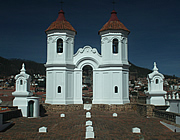
Two Spanish Colonial cities, with quite different origins.
The White City of Sucre was the original capital of Bolivia and its distinguished history and beautiful architecture have made it a World Heritage Site.
Potosi is built on silver - literally. A tough,hard-working city, dominated by the hill riddled with mining tunnels, it also has some fine buildings.
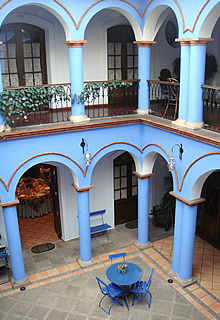
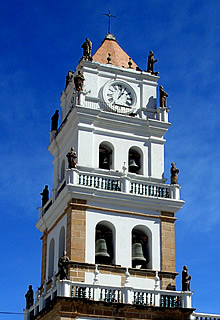
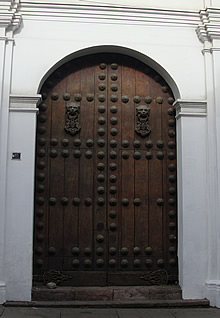
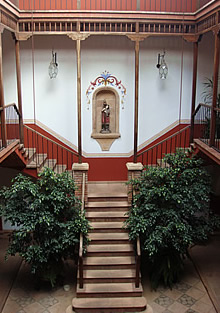
We flew from La Paz to Sucre, though the flight was almost cancelled due to thick cloud over Sucre. Apparently this often causes flights to be cancelled but we were OK. Landing was a bit of an experience, the plane seeming to drop very low without any sign of civilisation, the ground then dropped away, we landed and used the full length of the runway to come to a halt!
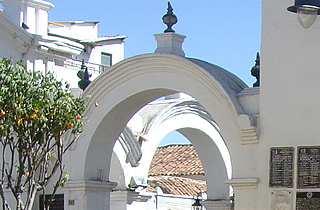
Our guide and driver were there to meet us and take us straight to our hotel, the Parador Santa Maria which was orignally a fine colonial home complete with stables. It has two cloistered, covered courtyards one of which is painted blue.
Known as the White City, all the major buildings in Sucre are painted white, which was the original colonial colour. It really does look beautiful, very dazzling in the bright sun.
Sucre was founded in 1538, a true spanish colonial city. Originally it was called La Plata but was given the name of Sucre in honour of the revolutionary leader Antonio Sucré. From 1825 to 1899 it was the capital city, but after a civil war La Paz became capital. It is certainly a bone of contention in the city. It's rather a confusing situation, as Sucre remains the constitutional capital and is the home of the Supreme Court, but all other government and administrative functions are located in La Paz.
The most important buildings are located around Plaza 25 de Mayo - the date is significant as the start of the struggle for independence from the Spanish in 1809. The square is a large tree-filled space surrounded by roads, the city being built on a rectangular grid system.
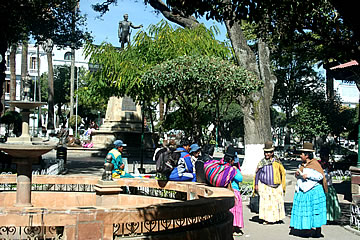
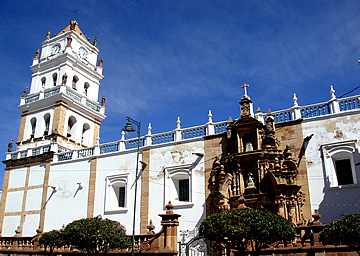
On the southern corner stands the Cathedral, completed in 1712. It has a beautiful open-sided bell tower with statues of the twelve apostles and four patron saints of Sucre.
Next to the Cathedral is the Prefecture. When Sucre was Bolivia's capital this was the seat of government.
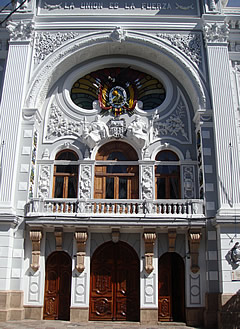
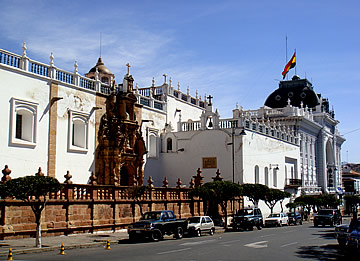
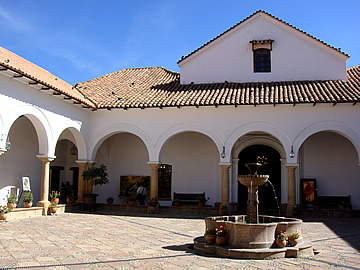
On the north west side of the plaza is the Casa de la Libertad where the Declaration of Independence was signed on August 6th 1825, making this date Independence Day. The people of Sucre are very proud of their heritage and, not surprisingly, make much of the Casa de la Libertad. Originally a sixteenth century Jesuit university, the first government assembly took place here and the lower house met in what used to be the Jesuit chapel. Here the Bolivian Constitution, drafted by Simón Bolivar, was approved, and, when Sucre was no longer the seat of the Bolivian Government, the building became an archive and museum. The short guided tour is very good, giving a potted history of the country and Sucre's role in independence, without becoming too involved.
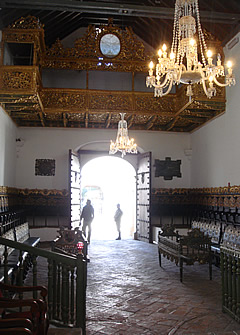
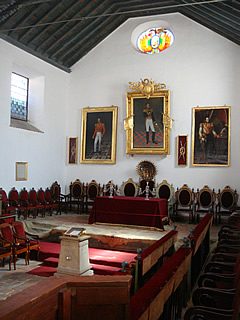
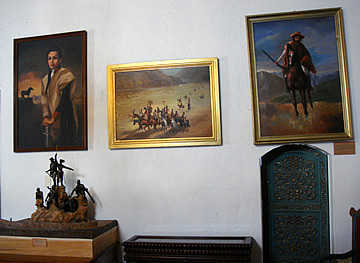
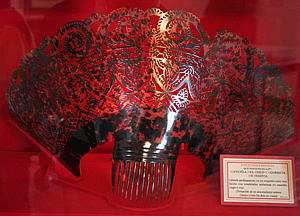
The Sala de los Guerrilleros holds numerous paintings of famous revolutionaries, including Doña Juana Azurduy de Padilla. Born in Sucre she was Mestizo: half Spanish, half indigenous Indian. She grew up to lead an army against the Spanish in the wars of independence of both Bolivia and Argentina.
One item on display that really caught my eye was a fabulous, intricately carved tortoiseshell peineta, which belonged to Manuela del Risco y Agorreta de Segovia.
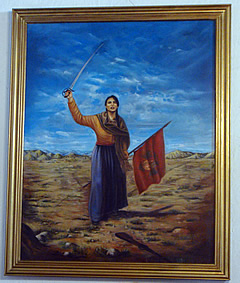
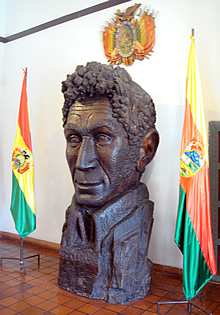
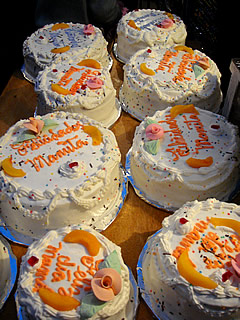
The Central Market was great fun to wander round - extremely busy both times we dropped in. It happened to be Mother's Day weekend and there was a roaring trade in extremely sweet-looking gaudily decorated cakes. One stall-holder let us taste the cake: quite a moist sponge topped with whipped cream.
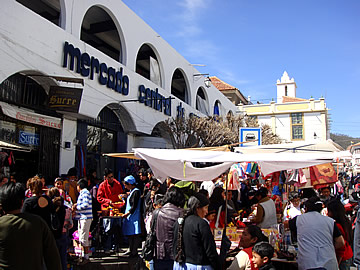
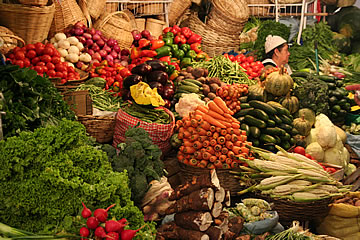
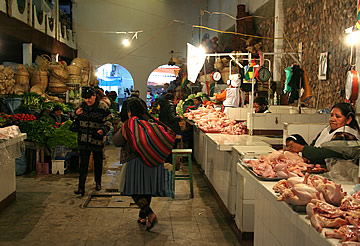
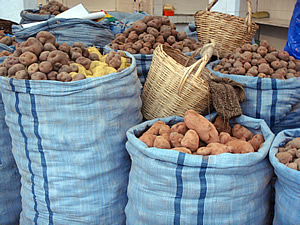
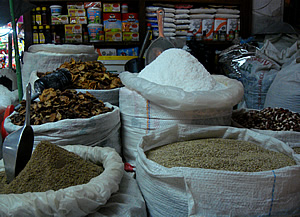
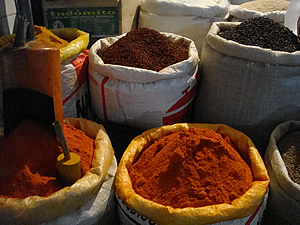
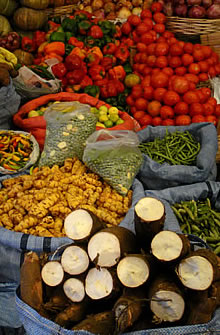
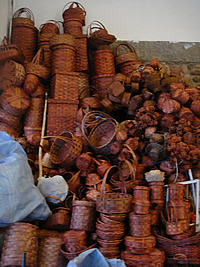
We saw some strange vegetables alongside all the more usual things. Huge quantities of potatoes were mostly sold from vast blue sacks in a small courtyard within the market.
Spices, pulses and grains - including almost certainly the ubiquitous quinoa, the greyish granular substance in sacks, right.
There are vast amounts of fruit and vegetables here - all looking gorgeous and beautifully displayed.
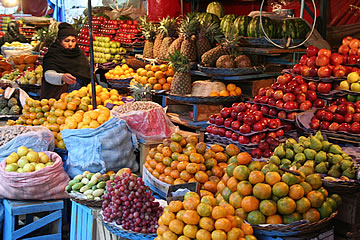
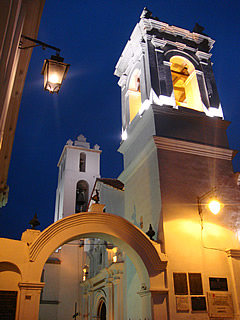
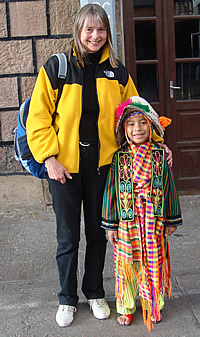
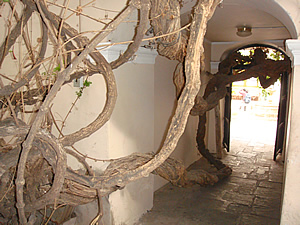
Near the market is the church of San Francisco and a pretty little square, though with very little shade, where we ate excellent chicken saltinas - our guide Elvis had shown us a good place to get them near here in a side street. Saltinas are a golden pastry-wrapped savoury - in this case chicken in a sauce - messy but very good!
Elvis had been to university here and took us to see where he studied at the School of Languages. A huge vine snakes through the passageways and looks as though it will bring down the building in the not-too-distant future!
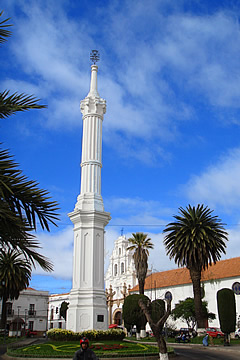
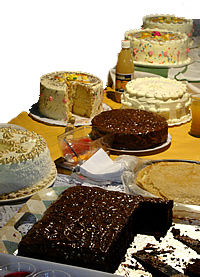
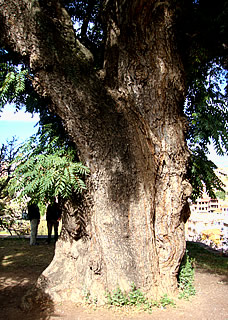
At one point on our wanderings with Elvis we passed a school where children were putting performances on for some kind of competition and Elvis said it would be OK to watch for a while. The children and their families were really enthusiastic and one father of a lovely little boy dressed in Potosi area traditional costume was very keen to have his photograph taken with me - I hope he won something!
North west of the Plaza 25 de Mayo is Plaza Libertad flanked by the sixteenth century Hospital Santa Barbara and with a beautiful obelisk in its centre. It was paid for with fines from bakers caught cheating on the size or weight of the bread they sold.
North of the plaza are the Supreme Courts of Justice - the reasons why Sucre remains the constitutional capital - and Parque Bolivar, a large green space with stalls selling cakes along the footpaths - though this may just have been for Mother's Day.
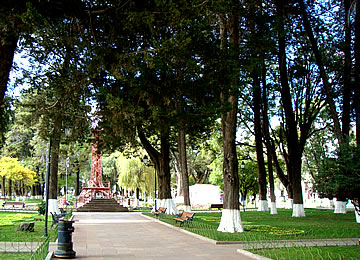
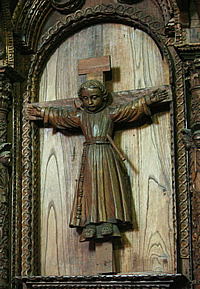
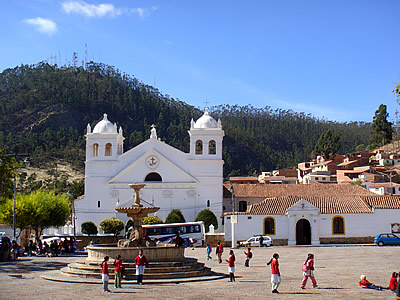
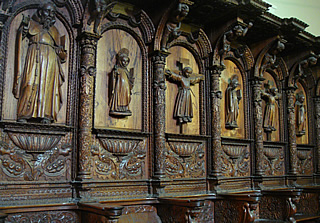
In the hills to the south east lies the sixteenth century Franciscan Convent of La Recoleta, now a museum of mainly paintings. It has lovely peaceful cloisters and in its grounds is an enormous cedar, 1400 years old. Furniture, devotional and other items were carved from cedar for the convent - apparently the gardens used to be full of cedar trees. There is a set of very impressive cedar choir stalls with carved saints and sweet little martyrs pinned by lances. We weren't so keen on the collection of very gloomy paintings!
The two hills behind La Recoleta are Sicasica and Churuquella.
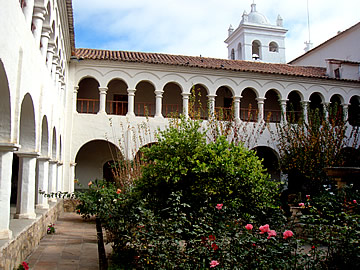
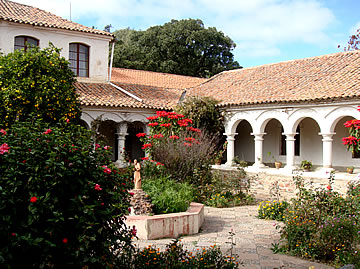
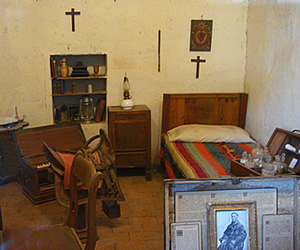
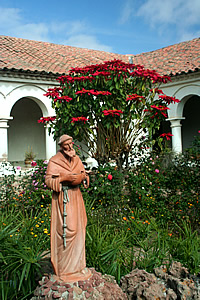
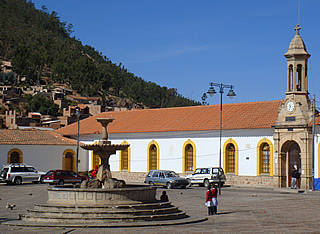
The courtyard in front of La Recoleta was full of playful children and the colonnaded walk on one side has fine views out over the city to the arid hills beyond.
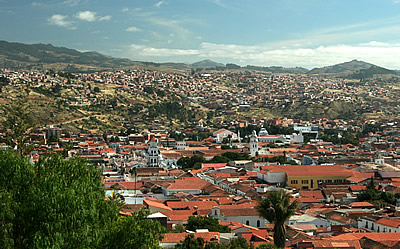
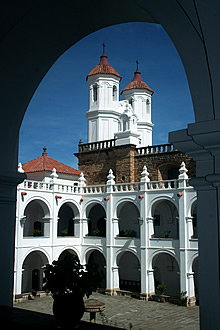
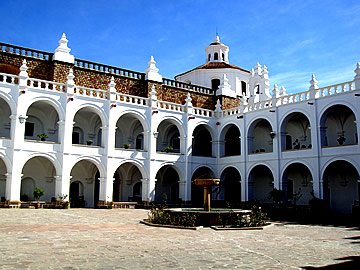
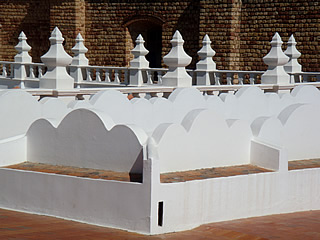
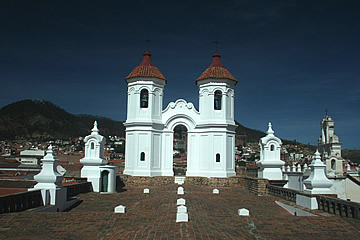
Finally to the place we thought the most beautiful in Sucre: San Felipe Neri. Once a monastery, now a rather exclusive girls' school, we walked through the quiet cloisters - all the children had left for the day. Climbing to the roof we discovered a white-as-icing sugar pinnacled scene - reminiscent of a Gaudi roof in Barcelona, not as quirky but much more beautiful. On the roof are penitents' benches, no doubt used in all weathers.
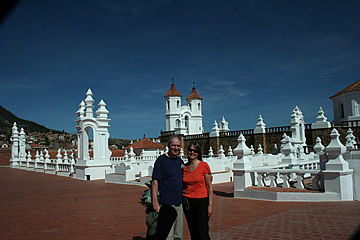
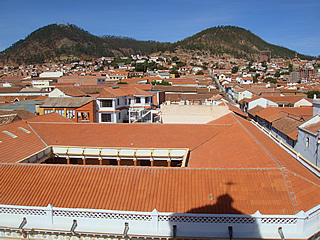
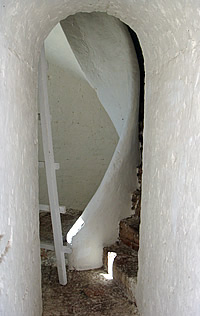
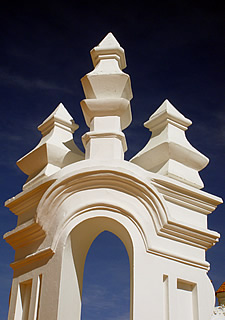
As we were leaving we saw a lovely painting of "The Last Supper", complete with main course of guinea pig. We'd seen something similar in the cathedral in Cuzco but hadn't been able to take a photograph there.
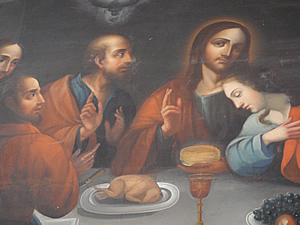
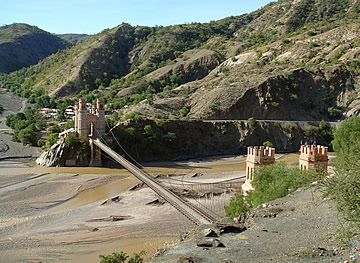
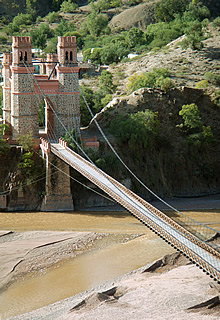
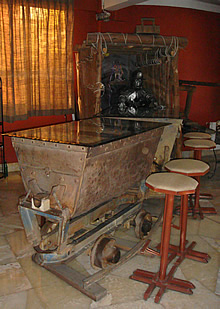
The drive from Sucre to Potosi takes about two and a half hours, travelling up through arid hills to an altiplano which is cultivated, growing wheat and may varieties of potato. We stopped at a rather splendid bridge crossing the Rio Pilcomayo, marking the border between Sucré and Potosi districts.
The first sign of Potosi was Cerro Rico - Rich Hill - glowing in the evening sun. Potosi was founded by the Spaniards in 1545 specifically to exploit the mines which already existed here. At 4000m above sea level it is the highest city of its size in the world.
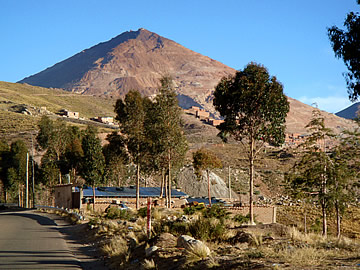
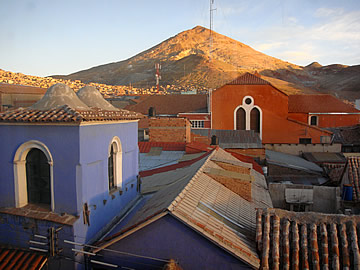
Cerro Rico dominates the city and is a rabbit warren of tunnels having been worked continuously for over 500 years. A wealth of silver has been removed from the hill, it seems to be the only one in the area like this. Later tin became the most important commodity for the town - a metal the Spaniards had no interest in. It is speculated that there are so many networks of tunnels in Cerro Rico that it could collapse at any time.
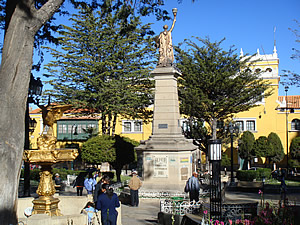
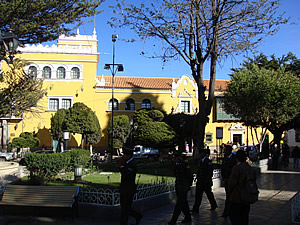
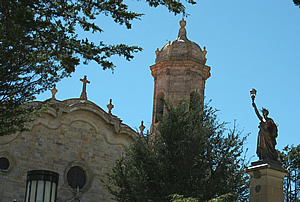
We were staying at the Coloso, one of the best hotels in the city, but still very bleak. A lavish marble staircase and floors make it even colder than necessary - especially with the front door continually blowing open. The lobby had the weirdest bar I've ever seen, made from mine wagons with glass covers complete with a metal miner emerging from a makeshift tunnel! Our room was fine and had a heater which was the main thing, because it was getting very cold at this altitude - fortunately I'd brought my ski thermals!
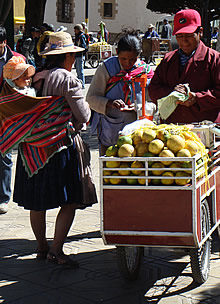
We opted not to visit the mines which are particularly bad working environments - it seemed rather intrusive to go to watch people working in such terrible conditions as if they were museum exhibits, though they probably welcome visitors as it is traditional to take gifts of dynamite and coca leaves, bought in the market. Plus we'd read of the poisonous atmosphere, 40°C heat, strenuous back-bending hikes along dark narrow tunnels and the possibility of asbestos, amongst other noxious substances, in the air. The miners have much shortened life spans due to the dreadful working conditions - probably the almost pure alcohol they drink and the coca leaves they constantly chew don't help.
The best of Potosi is colonial. The Plaza 10 de Noviembre is a pleasant shady square surrounded by important buildings including the Cathedral.
Nearby is the Casa Nacional de Moneda: the second Mint built when the first became inadequate for the city's needs. It is well worth seeing, the original buildings now hold a museum which includes the history of money in the city.
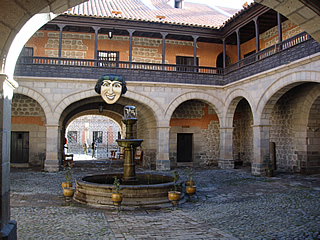
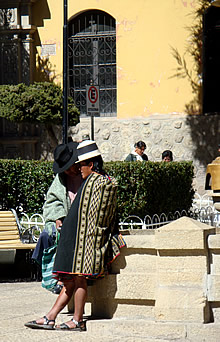
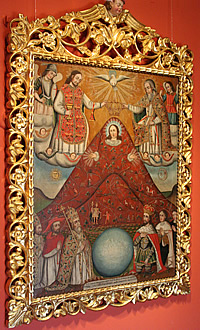
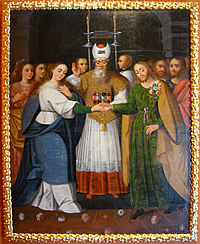
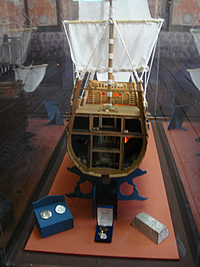
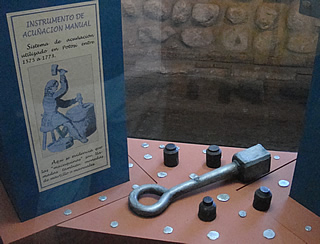
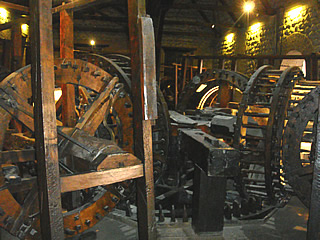
We had our own guide in the museum and she was very good. The building itself is huge and looks almost new in many rooms. Built in the mid-eighteenth century it takes up a whole block of the city. Here coins were minted from the silver mined from Cerro Rico, then shipped to Spain.
There are a few very nice paintings, much better than those we'd seen in Sucré. I particularly liked the Madonna shaped like Cerro Rico and a Marriage of Mary and Joseph - poor Joseph so rarely gets a look in! But the main event is the history of coinage and minting.
Some of the very earliest hand-hammered coins are on display, proceeding through donkey-powered pressing of ingots, steam-powered to electric machines. The early machinery is a combination of wood and iron, looking very heavy and indestructible.
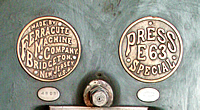
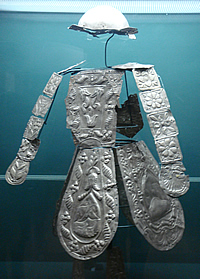
There are glass cases of fine items made from silver and a small hall with more ancient stone artefacts and pottery and mummified children - also in glass cases. The mummies were dressed and their faces were very well-preserved - a bit too macabre for me.

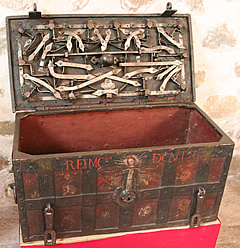
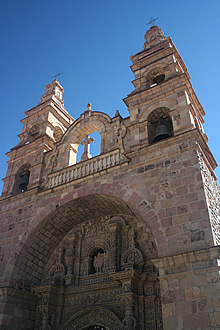
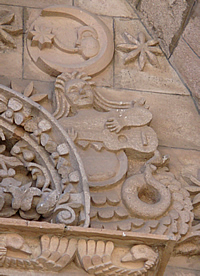
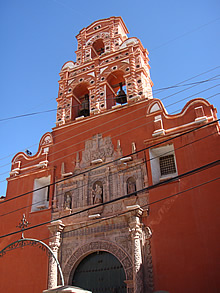
There is also a huge hall full of different minerals - I think probably only true aficionados could spend much time in here!
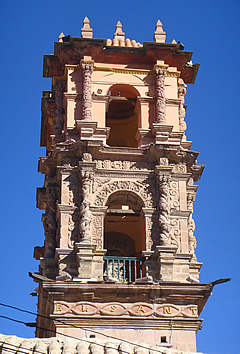
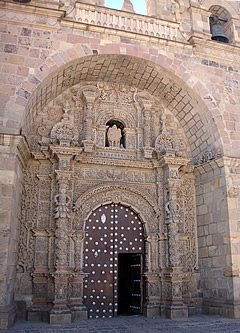
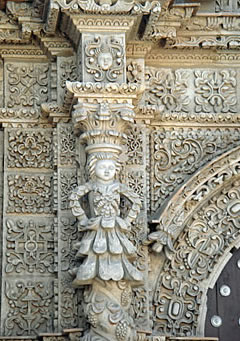
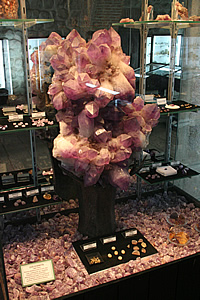
Potosi has fine examples of eighteenth century mestizo architecture, a mixture of traditional Bolivian styles and Spanish baroque. One of these is the Compania de Jesus church and bell tower (now a tourist office) near to the Casa de Monada. Every column is covered by a spiralling vine bearing fat bunches of grapes.
My favourite was San Lorenzo - who could resist a facade with guitar-playing mermaids and bare-breasted beauties holding up the entrance arch! Lots of ducks (at least they look like ducks) decorate the friezes.
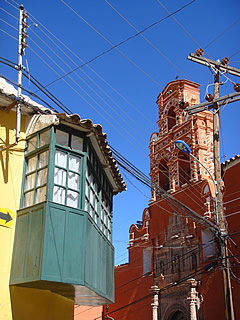
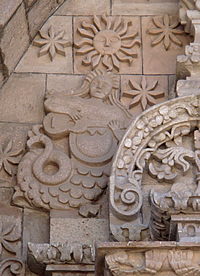
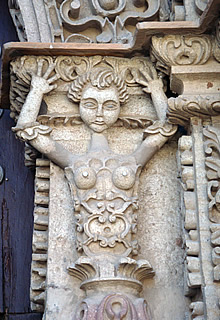
The seventeenth century Carmelite Convent of Santa Teresa is built in beautiful warm brick and umber plaster work.
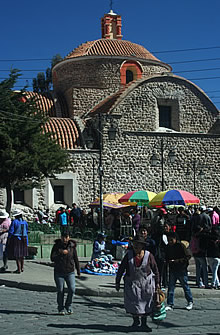
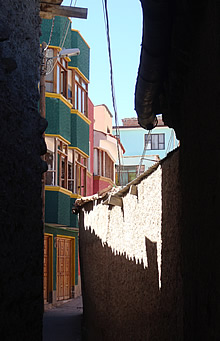
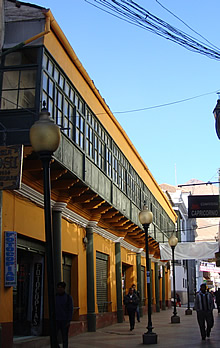
Rich families paid huge amounts to have their daughters admitted here and competition for places was fierce. The daughters never saw their families or anything of the outside world again. Visits were confined to conversations through a grill. Although it is still a convent, numbers are much diminished and many of the buildings form a museum.
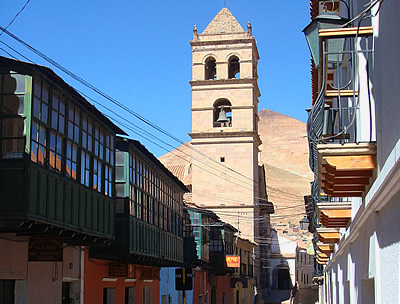
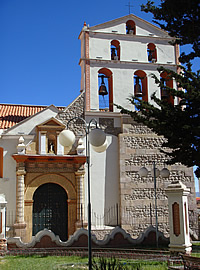
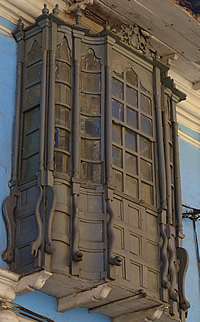
This being a Spanish Colonial city there are lots of glassed-in balconies and colourfully painted walls.
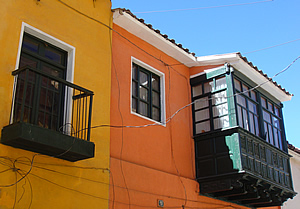
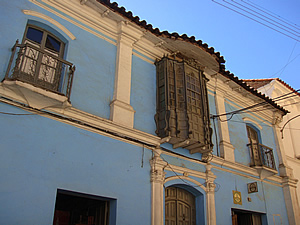
One of the more impressive houses had a balcony with drainpipes shaped like snakes!
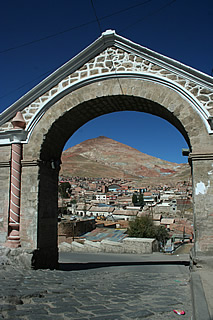
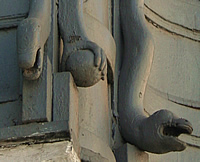
After visiting the market for supplies for our guide, including coca leaves, we left Potosi skirting Cerro Rico on its western flank heading south to Uyuni.
We passed through a landscape of mountains and canyons, which kept our minds off the deteriorating road - unpaved much of the way. Our four wheel drive was more than up to it, though, and we had a very good driver.
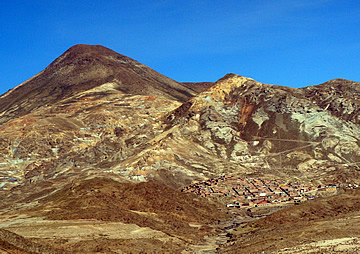
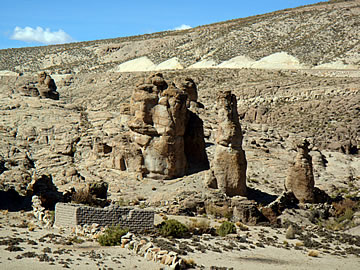
We stopped at one point where a bridge to carry the new road was being constructed, supported by a vast structure of wooden scaffolding.
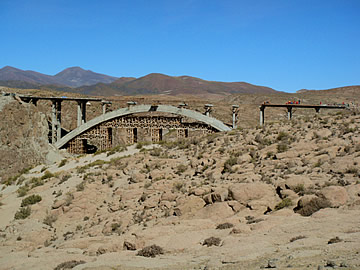
We saw huge herds of grazing llamas - and donkeys and sheep. Quite substantial sand dunes appeared at one point.
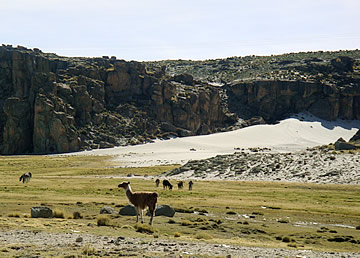
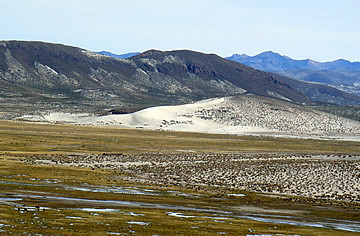
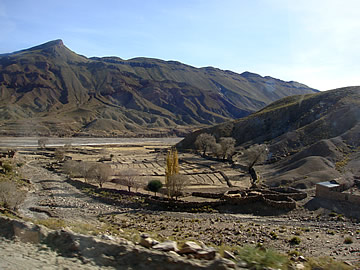
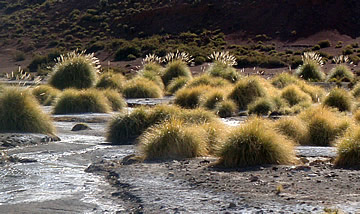
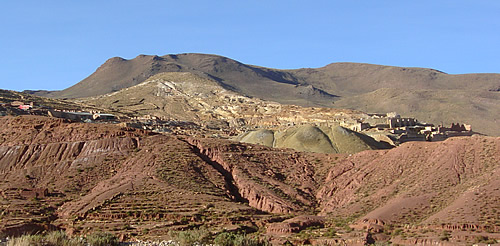
We also passed through, Pulacayo, originally a very large silver mining town, it exploited Huanchaca, the largest silver mine in Bolivia. All but abandoned now, the population has dwindled from tens of thousands at its peak to perhaps a few hundred.
There are also a lot of decaying trains here, including one that Butch Cassidy and the Sundance Kid famously robbed.
An extremely bleak place, we didn't linger but carried on to Uyuni.